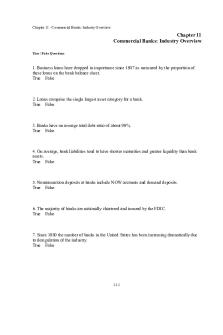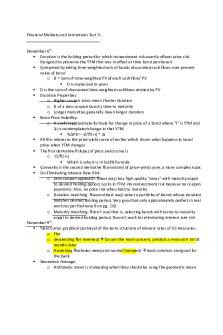7 Financial markets - summary pdf PDF

| Title | 7 Financial markets - summary pdf |
|---|---|
| Course | Accounting |
| Institution | De La Salle University |
| Pages | 140 |
| File Size | 3.1 MB |
| File Type | |
| Total Downloads | 222 |
| Total Views | 822 |
Summary
LEONARDO DA VINCITransfer of InnovationVALDONĖ DARŠKUVIENĖVytautas Magnus UniversityFinancial MarketsLeonardo da Vinci programme project„ Development and Approbation of Applied Courses Based on the Transfer of Teaching Innovations in Finance and Management for Further Educationof Entrepreneurs and S...
Description
LEONARDO DA VINCI Transfer of Innovation
VALDONĖ DARŠKUVIENĖ Vytautas Magnus University
Financial Markets
Leonardo da Vinci programme project
„Development and Approbation of Applied Courses Based on the Transfer of Teaching Innovations in Finance and Management for Further Education of Entrepreneurs and Specialists in Latvia, Lithuania and Bulgaria” 2010
TABLE OF CONTENTS Table of contents............................................................................................................... 2 Introduction ...................................................................................................................... 5 1. FINANCIAL MARKETS: STRUCTURE AND ROLE IN THE FINANCIAL SYSTEM .......................................................................................................................... 6 1.1. Financial system structure and functions............................................................ 6 1.2. Financial markets and their economic functions................................................. 7 1.3. Financial intermediaries and their functions ....................................................... 9 1.4. Financial markets structure .............................................................................. 11 1.4.1. Financial instruments ............................................................................... 11 1.4.2. Classification of financial markets ........................................................... 13 1.5. Financial market regulation ............................................................................. 14 1.6. Summary ......................................................................................................... 15 Key terms.................................................................................................................... 15 Further readings .......................................................................................................... 16 Review questions and problems .................................................................................. 16 2. INTEREST RATES DETERMINATION AND STRUCTURE............................... 17 2.1. Interest rate determination ............................................................................... 17 2.1.1. The rate of interest ................................................................................... 17 2.1.2. Interest rate theories: loanable funds theory ............................................. 19 2.1.3. Interest rate theories: liquidity preference theory ...................................... 20 2.2. The structure of interest rates........................................................................... 20 2.3. Term structure of interest rates......................................................................... 22 2.4. Theories of term structure of interest rates ....................................................... 22 2.4.1. Expectations theory.................................................................................. 23 2.4.2. Liquidity premium theory ........................................................................ 25 2.4.3. Market segmentation theory..................................................................... 26 2.4.4. The preferred habitat theory ..................................................................... 26 2.5. Forward interest rates and yield curve.............................................................. 26 2.6. Summary ......................................................................................................... 29 Key terms.................................................................................................................... 29 Further readings .......................................................................................................... 30 Relevant websites........................................................................................................ 30 Review questions and problems .................................................................................. 30 3. MONEY MARKETS .............................................................................................. 33 3.1. Money market purpose and structure ............................................................... 33 3.1.1. The role of money markets....................................................................... 33 3.1.2. Money market segments .......................................................................... 34 3.1.3. Money market participants....................................................................... 36 3.2. Money market instruments .............................................................................. 37 3.2.1. Treasury bills and other government securities......................................... 37 3.2.2. The interbank market loans ...................................................................... 42 3.2.3. Commercial papers .................................................................................. 43 3.2.4. Certificates of deposit .............................................................................. 45 3.2.5. Repurchase agreements............................................................................ 46 3.2.6. International money market securities ...................................................... 49 3.3. Money market interest rates and yields ............................................................ 51 3.4. Summary ......................................................................................................... 54 Key terms.................................................................................................................... 54
2
Further readings .......................................................................................................... 54 Relevant websites........................................................................................................ 55 Review questions and problems .................................................................................. 55 4. DEBT MARKETS .................................................................................................. 57 4.1. Debt market instrument characteristics ............................................................ 57 4.2. Bond market .................................................................................................... 59 4.2.1. Bond market characteristics ..................................................................... 59 4.2.2. Bond market yields .................................................................................. 60 4.3. Bond valuation ................................................................................................ 61 4.3.1. Discounted models................................................................................... 61 4.3.2. Bond duration and risk ............................................................................. 63 4.3.3. Bond price volatility ................................................................................ 63 4.3.4. Behavior of Macaulay’s duration ............................................................. 65 4.3.5. Immunization........................................................................................... 65 4.3.6. Bond convexity........................................................................................ 65 4.4. Bond analysis .................................................................................................. 67 4.4.1. Inverse floaters and floating rate notes ..................................................... 67 4.4.2. Callable bonds ......................................................................................... 67 4.4.3. Convertible bonds .................................................................................... 69 4.5. Summary ......................................................................................................... 70 Key terms.................................................................................................................... 71 Further readings .......................................................................................................... 71 Review questions and problems .................................................................................. 71 5. EQUITY MARKET ................................................................................................ 73 5.1. Equity instruments........................................................................................... 74 5.1.1. Common shares ....................................................................................... 74 5.1.2. Preferred shares ....................................................................................... 75 5.1.3. Private equity........................................................................................... 77 5.1.4. Global shares and American Depository Receipts (ADR)......................... 78 5.2. Primary equity market ..................................................................................... 80 5.2.1. Primary public market.............................................................................. 80 5.3. Secondary equity market ................................................................................. 83 5.3.1. Organized exchanges ............................................................................... 84 5.3.2. Over-the-counter (OTC) market ............................................................... 86 5.3.3. Electronic stock markets .......................................................................... 87 5.4. Secondary equity market structure ................................................................... 88 5.4.1. Cash vs forward markets .......................................................................... 89 5.4.2. Continuous markets and auction markets ................................................. 89 5.4.3. Order-driven markets and quote-driven markets....................................... 89 5.4.4. Hybrid markets ........................................................................................ 91 5.5. Equity market transactions............................................................................... 91 5.5.1. Bid-ask spread ......................................................................................... 91 5.5.2. Placing order............................................................................................ 93 5.5.3. Margin trading ......................................................................................... 95 5.5.4. Short selling............................................................................................. 97 5.5.5. Stock trading regulations.......................................................................... 98 5.6. Equity market characteristics ......................................................................... 100 5.6.1. Stock indicators ..................................................................................... 100 5.6.2. Stock market indexes ............................................................................. 100 5.6.3. Stock market indicators.......................................................................... 103 5.6.4. Transaction execution costs.................................................................... 104 5.7. Stock market efficiency ................................................................................. 106
3
5.8. Stock valuation .............................................................................................. 109 5.8.1. Fundamental analysis............................................................................. 109 5.8.2. Technical analysis.................................................................................. 110 5.9. Processes of consolidation of stock exchanges ............................................... 114 5.10. Summary ................................................................................................... 115 Key terms.................................................................................................................. 116 Further readings ........................................................................................................ 116 Relevant websites...................................................................................................... 117 Review questions and problems ................................................................................ 118 6. DERIVATIVES MARKETS ................................................................................. 120 6.1. Hedging against risk ...................................................................................... 120 6.2. Description of derivatives markets................................................................. 120 6.3. Forward and futures contracts ........................................................................ 122 6.3.1. Principles of forward and futures contracts............................................. 122 6.3.2. Forward and futures valuation................................................................ 124 6.3.3. Use of forwards and futures ................................................................... 127 6.3.4. Futures contracts: stock index futures..................................................... 129 6.3.5. Contracts for difference (CFD) .............................................................. 130 6.4. Swaps............................................................................................................ 131 6.5. Options.......................................................................................................... 132 6.5.1. Options definition .................................................................................. 132 6.5.2. Components of the Option Price ............................................................ 135 6.5.3. Determinants of the Option Price ........................................................... 136 6.5.4. Option pricing models............................................................................ 138 6.5.5. Mixed strategies in options trading......................................................... 139 6.6. Summary ....................................................................................................... 139 Key terms.................................................................................................................. 140 Review questions and problems ................................................................................ 140
4
INTRODUCTION Motivation for developing the course Research by the members of the project consortium Employers’ Confederation of Latvia and Bulgarian Chamber of Commerce and Industry indicated the need for further education courses in the field of finance and managerial decision making. Innovative content of the course The course has been developed to include the following innovative content: Key concepts of financial markets, which are explained from an applied perspective, including with examples and problems from current financial markets practices from EU integration and development perspective; Analytical techniques to be applied in financial markets provide with understanding and tools to decision makers in the firm; Applied exercises, which cover topics such as money market, debt market, equity market instruments, as well as decision making rules in the financial markets; Summaries are provided at the end of every chapter, which aid revision and control of knowledge acquisition during self-study; Innovative teaching methods of the course The course is developed to utilise the following innovative teaching methods: Availability on the electronic platform with interactive learning and interactive evaluation methods; Active use of case studies and participant centred learning; Availability in modular form; Utilising two forms of learning - self-study and tutorial consultations; Availability in several languages simultaneously. Target audience for the course The target audience are: entrepreneurs, finance and management specialists from Latvia, Lithuania and Bulgaria and, in the longer term, similar groups in any other European country. The course assumes little prior applied knowledge in the area of financial and operation analysis. The course is intended for 32 academic hours (2 credit points). Course objective The objective of the course is to provide entrepreneurs with the knowledge in the area of financial markets, specific financial market instruments, behavior in order to enable them to understand the financial markets processes and their factors, and to make successfully financial decisions on the individual as well as company level.
5
1. FINANCIAL MARKETS: STRUCTURE AND ROLE IN THE FINANCIAL SYSTEM Mini contents
The structure of a financial system Functions of a financial system The structure and key features of financial markets The key features of financial intermediaries Major financial market participants
1.1. Financial system structure and functions The financial system plays the key role in the economy by stimulating economic growth, influencing economic performance of the actors, affecting economic welfare. This is achieved by financial infrastructure, in which entities with funds allocate those funds to those who have potentially more productive ways to invest those funds. A financial system makes it possible a more efficient transfer of funds. As one party of the transaction may possess superior information than the other party, it can lead to the information asymmetry problem and inefficient allocation of financial resources. By overcoming the information asymmetry problem the financial system facilitates balance between those with funds to invest and those needing funds. According to the structural approach, the financial system of an economy consists of three main components: 1) financial markets; 2) financial intermediaries (institutions); 3) financial regulators. Each of the components plays a specific role in the economy. According to the functional approach, financial markets facilitate the flow of funds in order to finance investments by corporations, governments and individuals. Financial institutions are the key players in the financial markets as they perform the function of intermediation and thus determine the flow of funds. The financial regulators perform the role of monitoring and regulating the participants in the financial system.
Stock market Firms
Bond market Short term fixed securities market
Figure 1. The structure of financial system
6
Banking sector
Governments
Financial markets studies, based on capital market theory, focus on the financial system, the structure of interest rates, and the pricing of financial assets. An asset is any resource that is expected to provide future benefits, and thus possesses economic value. Assets are divided into two categories: tangible assets with physical properties and intangible assets. An intangible asset represents a legal claim to some future economic benefits. The value of an intangible asset bears no relation to the form, physical or otherwise, in which the claims are recorded. Financial assets, often called financial instruments, are intangible assets, which are expected to provide future benefits in the form of a claim to future cash. Some financial instruments are called securities and generally include stocks and bonds. Any transaction related to financial instrument includes at least two parties: 1) the party that has agreed to make future cash payments and is called the issuer; 2) the party that owns the financial instrument, and therefore the right to receive the payments made by the issuer, is called the investor. Financial assets provide the following key economic functions.
they allow the transfer of funds from those entities, who have sur...
Similar Free PDFs

7 Financial markets - summary pdf
- 140 Pages

Money and financial markets 1 .pdf
- 208 Pages

Chap011 - financial markets TB
- 26 Pages

Financial Markets and Institutions
- 35 Pages

Correction DM - Financial markets
- 19 Pages

Financial markets Test 3
- 13 Pages

Financial Institutes and markets
- 7 Pages

Financial Institutions and Markets
- 276 Pages

Chapter 3 Financial Markets
- 28 Pages

Financial Markets and Institution
- 20 Pages
Popular Institutions
- Tinajero National High School - Annex
- Politeknik Caltex Riau
- Yokohama City University
- SGT University
- University of Al-Qadisiyah
- Divine Word College of Vigan
- Techniek College Rotterdam
- Universidade de Santiago
- Universiti Teknologi MARA Cawangan Johor Kampus Pasir Gudang
- Poltekkes Kemenkes Yogyakarta
- Baguio City National High School
- Colegio san marcos
- preparatoria uno
- Centro de Bachillerato Tecnológico Industrial y de Servicios No. 107
- Dalian Maritime University
- Quang Trung Secondary School
- Colegio Tecnológico en Informática
- Corporación Regional de Educación Superior
- Grupo CEDVA
- Dar Al Uloom University
- Centro de Estudios Preuniversitarios de la Universidad Nacional de Ingeniería
- 上智大学
- Aakash International School, Nuna Majara
- San Felipe Neri Catholic School
- Kang Chiao International School - New Taipei City
- Misamis Occidental National High School
- Institución Educativa Escuela Normal Juan Ladrilleros
- Kolehiyo ng Pantukan
- Batanes State College
- Instituto Continental
- Sekolah Menengah Kejuruan Kesehatan Kaltara (Tarakan)
- Colegio de La Inmaculada Concepcion - Cebu





